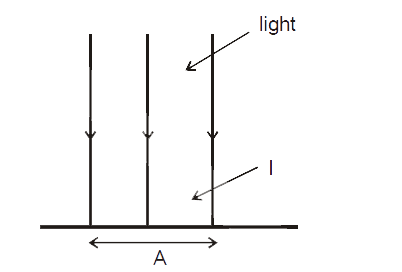Ultraviolet light of wavelength 66.26 nm and intensity 2W/m2 falls on potassium surface by which photoelectrons are ejected out. If only 0.1% of the incident photons produce photoelectrons, and surface area of metal surface is 4m2, how many electrons are emitted per second?
2.67×1015
3×1015
3.33×107
4.17×1016
The correct Answer is:A
Number of photons falling on metal surface,
np=intensity×areaenergy per quanta
=(2Js−1m)×(4m2){(6.626×10−34Js)×(3×108ms−1)(66.26×10−9m)}
=2.67×1018 per sec
From equation, ne=0.1% of np
=0.1100×2.67×1018=2.67×1015 per sec
Topper's Solved these Questions
- CATHODE RAY, PHOTOELECTRIC EFFECT AND X-RAYSBOOK - BITSAT GUIDECHAPTER - CATHODE RAY, PHOTOELECTRIC EFFECT AND X-RAYSEXERCISE - BITSAT Archives
6 Videos
- ATOMIC STRUCTUREBOOK - BITSAT GUIDECHAPTER - ATOMIC STRUCTUREEXERCISE - BITSAT Archives
4 Videos
- CURRENT ELECTRICITYBOOK - BITSAT GUIDECHAPTER - CURRENT ELECTRICITYEXERCISE - Bitsat Archives
26 Videos
Similar Questions
Ultraviolet light of wavelength 350 nm and intensity 1W/m2 is directed at a potassium surface having work function 2.2 eV
(ii) if 0.5 percent of the incident photons produce photoelectric effect, how many photoelectrons per second are emitted from the potassium surface that has an area 1cm2.
Ekmax=1.3eV,n=8.8×1011photo electronsecondorr=Nhvt=nhv
View Solutionwhen a beam of 10.6eV photons of intensity 2.0W/m2 falls on a platinum surface of area 1.0×104m2 and work function 5.6eV,0.53% of the incidentphotons eject photoelectrons find the number of photoelectrons emited per second and their minimum energies (in eV)Take 1eV=1.6×10−19J
View Solution
Knowledge Check
Ultraviolet light of wavelength 300nn and intensity 1.0Wm−2 falls on the surface of a photosensitive material. If one per cent of the incident photons produce photoelectrons, then the number of photoelectrons emitted per second from an area of 1.0 cm2 of the surface is nearly
A9.61×1014s−1B4.12×1013s−1C1.51×1012s−1D2.13×1011s−1Light of wavelength 5000 Å and intensity of 3.96×10−3wa/cm2 is incident on the surface of photo metal . If 1% of the incident photons only emit photo electrons , then the number of electrons emitted per unit area per second from the surface will be
A9.82×1017m−2/2B9.82×1013m−2/sC9.82m−2/sDnone of theseUltraviolet beam of wavelength 280 nm is incident on lithium surface of work function 2.5 eV. The maximum velocity of electron emitted from metal surface is
A8.2×105m/sB106m/sC7×105m/sDNone of these
When a beam of 10.6 eV photons of intensity 2.0W/m2 falls
on a platinum surface of area 1.0×10−4m2 and work function 5.6 eV, 0.53% of
the incident photons eject photoelectrons. Find the number of photoelectrons
emitted per second and their minimum and maximum energy (in eV). Take
1eV=1.6×10−19J.
View SolutionA beam of light having wavelength λ and intensity 1 falls normally on an area A of a clean surface then
find out the number of photon incident on the surface.

View SolutionWhen light of intensity 1W/m2 and wavelength 5×10−7m is incident on a surface, it is completely absorbed by the surface. If 100 photons emit one electron and area of the surface is 1cm2 ,then the photoelectric current will be
View SolutionWhen ultraviolet lightofenergy6.2 eV incidents on a aluminimum surface, it emits photoelectrons. If work function for aluminium surface is 4.2 eV, then kinetic energy of emitted electrons is
View SolutionAssertion: A photosensitive surface is illuminated by a monochromatic light of wavelength λ and intensity I. The number of photoelectrons emitted per second is doubled when the intensity of light is doubled. However, the maximum speed of emitted electrons remains unchanged.
Reason: The number of electrons emitted per second is directly proportional to the intensity of the incident light. The kinetic energy of the emitted photoelectrons is independent of the intensity of the light.
View Solution
